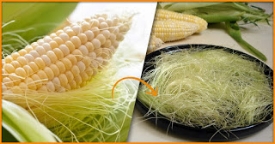Words On Wellness • Corn Silk
As grasses mature and dry on the headlands, birds, small rodents and insects, are harvesting their whole-grain goodness. For many people, a favorite summertime grass is corn-on-the-cob eaten as a fresh vegetable. Whether raw or cooked to your liking non-GMO whole corn kernels are packed with vitamin C, magnesium, phosphorous, iron, fiber and a healthy dose of two antioxidants that nourish our eyes and skin: zeaxanthin and lutein. Unlike other foods, cooking actually increases the number of usable antioxidants in sweet corn. Organic corn (especially purple corn) is found to be a rich source of a phenolic compound called ferulic acid, an anti-carcinogenic agent shown to be effective in fighting the tumor cells attributed to breast and liver cancer.
When corn is dried and used in cooking as masa, polenta or cornstarch, we refer to it as a grain, yet corn is classified by botanists as a fruit. Indeed, it is packed with sugar and we eagerly shuck the tight husk to get to the sweet kernels - but wait, don’t throw the stringy corn silk away! Each silky hair is a hollow tube that comes from the female part (ovary) on the ear. This silk grows outside of the husk until the pollen lands on it and moves down the silk tube to fertilize the ovary to form the seed/kernel. Every ear of corn has one silk strand per kernel. The hollow tube of silk is a signature to its medicinal affinity for treating the urinary tract.
Collecting your own corn silk is superior to anything you can buy. Simply set aside the silk to dry and store for later use, or make a fresh tea by breaking some into a cup and pouring hot water over to sit covered for 20 minutes. This mild tea is a soothing diuretic and used to help relieve kidney stones, cystitis, bladder infections and fluid retention. It has long been part of formulas for treating bed-wetting or prostate gland enlargement and is able to inhibit certain bacteria from sticking to the lining of urinary tract cells.
Finally, the husk itself can be used as a wrapper in cooking tamales, sticky rice or fish. You can even add washed corn husks to your stock pot for extra-woody flavor – nice for a mushroom soup or corn chowder.







